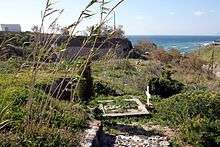Spyridon Marinatos
Spyridon Nikolaou Marinatos (Greek: Σπυρίδων Νικολάου Μαρινάτος; November 4, 1901 – October 1, 1974) was a Greek archaeologist.
Spyridon Marinatos | |
|---|---|
| Born | November 4, 1901 |
| Died | October 1, 1974 (aged 72) Santorini, Greece |
| Nationality | Greece |
| Known for | Santorini excavation and his theory on the volcanic destruction of Minoan Crete |
| Scientific career | |
| Fields | Archaeology |
Career
Marinatos began his career in Crete as director of the Heraklion Museum along with Georgia Andrea in 1929 where he met Sir Arthur Evans. He conducted several excavations on Crete at Dreros, Arkalochori, Vathypetro and Gazi, all of which resulted in spectacular finds. In 1937, he became director of the Antiquities service in Greece for the first time. Shortly afterwards, he became professor at the University of Athens. He turned his attention to the Mycenaeans next, regarding them as the first Greeks. He excavated many Mycenaean sites in the Peloponnese, including an unplundered royal tomb at Routsi, near Pylos. He also dug at Thermopylae and Marathon uncovering the sites where the famous battles had occurred.

His most notable discovery was the site of Akrotiri, a Minoan port city on the island of Thera. The city was destroyed by a massive eruption which buried it under ashes and pumice. The tsunamis created by the eruption destroyed coastal settlements on Crete as well. Guided by the local Nikos Pelekis, Marinatos began excavations in 1967 and died at the site in 1974, after suffering a massive stroke. According to another version, he died during the excavation as he was hit by a collapsing wall.[1]
Politics
He was director-general of antiquities for the Greek Ministry of Culture during the Greek military junta of 1967–74 (Regime of the Colonels). The acquaintance he cultivated with the colonels who were in power in Greece, especially the leader of the military junta, Georgios Papadopoulos, was ideologically based. Professor Marinatos was a nationalist in many regards whose ideals, some of his political opponents allege, influenced his archaeological work. Although no evidence of so-called "ideological influence" regarding his actual work (which was highly respected, and world-renowned to this day) has ever been proven, his political affiliation created controversy among his academic peers nonetheless, since most of his peers who had political affiliations with communists or criticized the military junta, were fired or legally persecuted by the government of Papadopoulos. Eventually, Marinatos was fired too, by the dictator Ioannides, who made sure to get rid of all the close associates of Papadopoulos when he seized power in 1973.
Books
His Crete and Mycenae was originally published in German in 1960.[2] His most important article was about "the volcanic destruction of Minoan Crete" [Antiquity 1939]. His excavations at Thera have been published in six slender volumes (1968–74). "Life and Art in Prehistoric Thera" was one of his last publications in 1972.[3]
His name is mentioned in the video game Indiana Jones and the Fate of Atlantis, which also features a plot involving Thera and the legendary underwater lost city.
The book Voyage to Atlantis, written by James W Mavor, Jr., details the 1967 excavation of Thera, over which Marinatos presided. The book mentions how Marinatos was, at the same time, aiming to become the Director of Antiquities at the National Archaeological Museum of Athens. The book also makes note of the political atmosphere in Greece at the time.[4]
Archaeological sites
Marinatos was responsible for excavations at:
See also
- National Archaeological Museum of Athens
- Archaeological Museum of Chora
References
- The Excavation of Akrotiri www.santorin.gr
- Kreta und das Mykenische Hellas ( Spyridon Marinatos, 1960.
- Proceedings of the British Academy, Vol. 57 (1972)
- Mavor, James W Jr (1969). Voyage to Atlantis. Rochester, Vermont: Park Street Press. ISBN 0-89281-634-1.